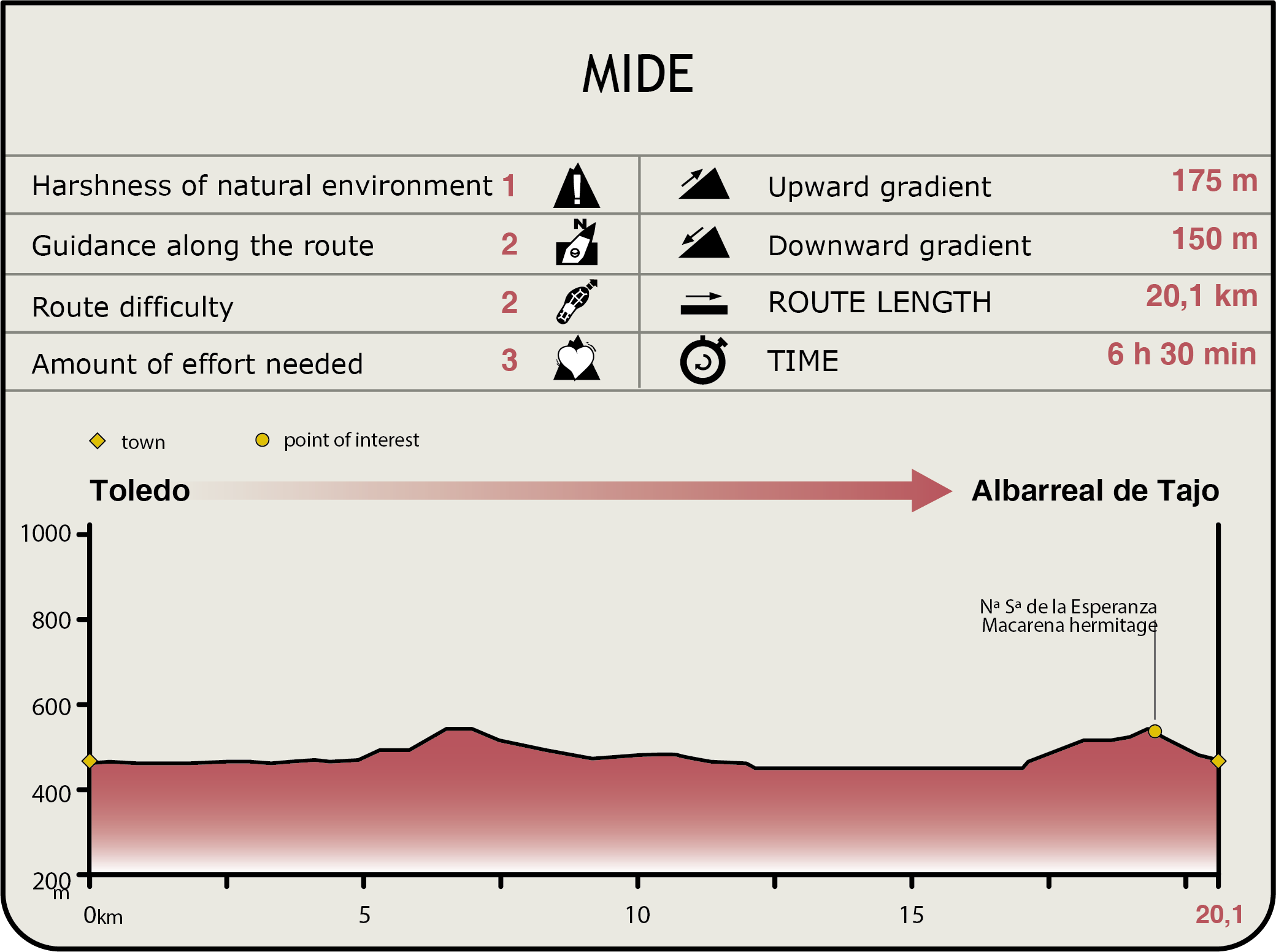Stage 22: Toledo - Albarreal de Tajo
Description

The Tagus flows to Albarreal del Tajo through rolling hills
The route leaves the Imperial City crossing an area under the bridges of San MartÃn and Cava, then proceeds along a beautiful river promenade. It continues along old workshops that have now been transformed into a recreational area and promenade. Some buildings, with walkways that jut out over the River Tagus, allow the traveller to see places that are laden with history, including the Polvorines Bridge, at the edge of Toledo.
Two kilometres further on, the Trail reaches a road and continues to the left towards the CM-40. The route passes through three roundabouts before reaching the road. It takes the second exit at the first roundabout, passing next to Toledo's wastewater treatment plant. At the second roundabout, it again takes the second exit, crossing a bridge under which the CM-40 passes. Finally, at the third roundabout, it takes the second exit, moving away from the paved road onto a track with a sign indicating "Camino de Albarreal".
The route passes next to a quarry with heavy traffic of lorries from the mine; however, the Trail only runs along this road for three kilometres. There is no possibility of error as the track is well signposted, indicating the direction towards La Vega de la Cruz.
This Stage traverses through large private farms that are usually fenced and marked as private game reserves. Indeed, it is possible to hear gunshots when walking through this area. Another interesting element of this Stage of the Nature Trail is that it overlaps during 5 kilometres with the Way of Saint James (GR 239), the pilgrimage route to Santiago de Compostela, that also runs through here. One must greet the pilgrims with the traditional "Buen Camino"
The path skirts around several large farms, including Bergonza, Viznagas and Vega de la Cruz. The route climbs a small hill before it reaches the latter farm. On top of the hill are a beautiful viewpoint and several picnic tables where the traveller can enjoy a well-deserved break.
The route continues to skirt around the farmlands of Vega de la Cruz along its southwest border. It is possible to see the chapel and olive groves of the farm. The Trail veers west towards the River Guadarrama, which it crosses via a narrow, yet sturdy bridge. From here, it gradually descends the rolling hills covered with fields of grain.
The gradual ascent leads to the Shrine of Nuestra Señora de la Esperanza Macarena, which dominates the horizon with its grandeur, surrounded by olive groves and rows of grain that paint the landscape yellow, grey and ochre hues in late summer. The last ascent leads to the shrine, which has an information panel that allows one to enjoy the building up close.
From this fabulous vantage, it is possible to see the endpoint of this Stage. All one has to do is descend directly towards Albarreal de Tajo and enter the village from the south. There is a rest area on the outskirts, next to a playground, and the village has several fountains where one can rest.
Sites of interest
Profile

MIDE (Method for the Information of Excursions)
Featured
Further information
Albarreal del Tajo
The origin of the name appears to come from the Celt word "albiga". However, in the 11th century, when Alphonse VI donated the village to the Monastery of San Servando de Toledo, it was known as Albalat, which in Arabic means "the road". In the sixteenth century, the name was changed to Albarreal, and then Alcalá del Río, with only 55 inhabitants who lived in earthen houses. It was granted a city charter in the 17th century, changing its name to Alba Real, in accordance with the title of their new masters, the Counts of Alba Real
The parish church of Asunción is worth visiting, as well as the city centre dotted with small whitewashed houses. The feast in honour of the patron saint, Saint Augustine, takes place on August 27, 28 and 29.